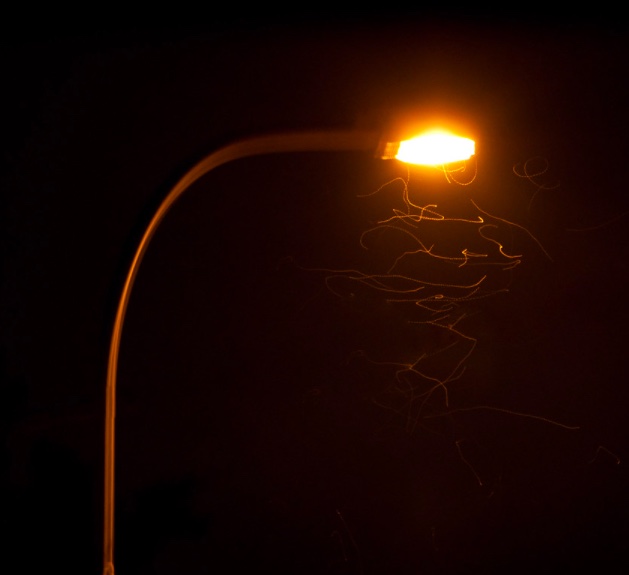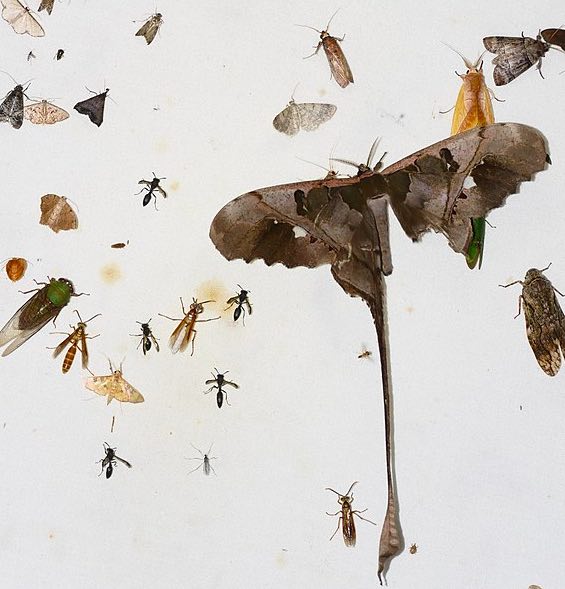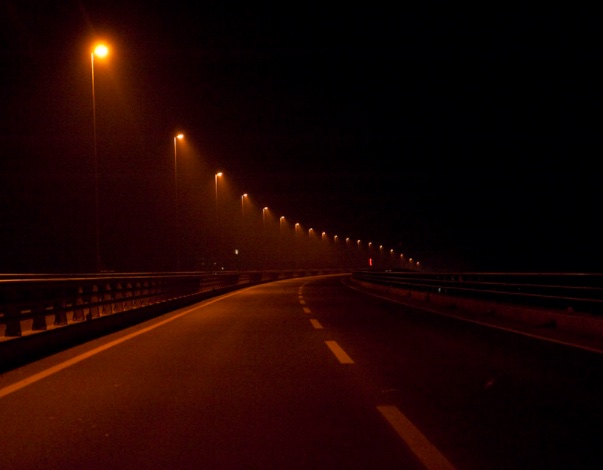
This past Thursday evening, not having done my usual run because of the heat, I waited until later when things had cooled down a bit. It was still quite humid and even faintly misty and not wanting to get all sweaty I opted to walk the four mile circle through the exurb north of Philadelphia where we live.
It was totally quiet as I walked the paved streets past the houses on one-acre lots with their neatly mowed lawns and sculpted flower patches.
At first I enjoyed the peaceful stillness of the windless evening and the lack of traffic or even other walkers, but then it dawned on me what made it seem to uniquely calm. As I passed streetlight after streetlight, I realized there was not a moth, beetle or other miscellaneous bug flying around any of the lights.
Over the course of four miles, I passed only two streetlights that had one flying insect each — both small moths.
Not surprisingly, there wasn’t a bat to be seen, though in prior years these amazing flying mammals wih their natural echo-locating sonar could be observed through such evenings in summer darting around and snatching up mosquitos, flies, beetles and moths.
I know that populations of the brown bats that were common in the northeastern US were sharply reduced by the white-nose fungus which was killing them while they hibernated through the winter. But they had seemed to be recovering from that epidemic, probably by developing immunity to the pathogen. Now, it was clear to me, the problem is simply starvation. With no bugs flying around in the evening, the bats have nothing to eat to support their rapid metabolisms.
Given all the violent and terrifying drama of this year’s examples of raging climate-emergency caused events, from unprecedented deadly storm flooding in western Europe to unprecedented heatwaves in both the western US and the Arctic from eastern Siberia across Alaska and northern Canada, as well as in Scandinavia, this story might seem a little “soft.”
That would be a mistake though. The absence of insects, or their dramatic decline, even in the daytime, is not just a massive canary in the ecological coal mine, but is a major environmental disaster.
It explains the paucity of birds which I’ve noted before. When, a little over two decades ago, we moved to our home here in southeastern Pennsylvania from Hong Kong, buying a colonial-era stone house on a wooded 2.3 acres that includes a vernal pond and lots of scrub brush, it was a different world. We had everything from cardinals, scarlet tanagers, shrikes, meadowlarks, starlings, chickadees, and goldfinches to sparrows, woodpeckers, nuthatches, hummingbirds, bluejays, robins, catbirds, cuckoos, crows, wrens, grackles, several varieties of hawks and owls, mourning doves and other birds as well a plenty of bats. There was a symphony of birdsong in the mornings, and plenty also through the day, as well as some at night, and of course loads of bats. Now I only see crows, a few bluejays and robins, an occasional wren or cardinal, and that’s about it, except for a dogged pair of vultures which over the years keep returning to the loft of our barn to lay two eggs that never manage to hatch before being eaten by some predator or other.
It’s the decline of bugs that is behind this increasingly impoverished ecology, I’m sure. Bugs are the base of the food chain for most birds, and bats, especially in the spring, summer and early autumn months. They provide the energy that these warm-blooded creatures need to fatten up before making their long migrations to warmer climes in winter if they are migratory, or to get through the winter here when food is scarcer, if they stay put. With the bugs gone or almost gone, the birds are starving. I suspect that their reproductive success rate is way down, as feeding nestlings must now be a real challenge. I suspect too that many are also dying during migration. In my mind’s eye, I see the horrible image of hummingbirds, those living jewels which normally zoom non-stop across the Gulf of Mexico a few feet above the waves to reach fall wintering grounds on the Yucatán Peninsula and surrounding areas of Central America after loading up on stored fat through the summer, now dropping mid-way into the sea from exhaustion to become just feathered chum for the fishes.
I grew more angry as I walked, noticing that none of the lawns I was passing had any dandelions or other weeds growing in them— not even clover, a staple for myriad varieties of bee, fly and butterfly. All one sees is blades of manicured grass. I noticed too leaves on the flowering plants in gardens near the sidewalks had no sign of the being nibbled by the many insects that thrive on leaves, the way my garden plants look (i use no chemicals on our flower and vegetable plants, which grow wild, organic and unkempt). What I was seeing was clear evidence of the widespread ignorant and antisocial use of toxic and carcinogenic glyphosate-laced herbicides as well, no doubt, as neonicotinoid-based insecticides.
Bugs are vanishing all over the world, both victims of climate change, and of the modern human predilection for picture-perfect lawns and weed-and-labor-free gardens.

I remember when we lived in Hong Kong, up on a hillside outside of Shatin at the start of the New Territories, how even though that British colony and now integral part of China is one of the world’s most densely populated municipalities, there were bugs everywhere. I used to be able, just 25 years ago, to walk around our university housing complex at night with my two-year-old son Jed, and let him “bop” the moths, walking sticks, katydids and miscellaneous other flying, crawling and hopping insects that had landed on the wall near light fixtures at building entryways. He loved to “bop” them gently on the abdomen with an index finger and watch with squeals of delight as they’d fly or hop off.
I wondered back then at how there could be so many bugs, from huge green Luna moths to frighteningly large katydids and flies, in such an urbanized place until I realized that nobody in Hong Kong has a lawn. The city is composed of densely populated centers — big cities like Hong Kong itself, and Kowloon across Victoria Harbour — but also so-called “new towns” that are built in a matter of years, each development consisting of paved over interior squares surrounded by 35-story tall apartment buildings designed to maximize rents on each hugely expensive acre of real estate. Sprawling suburbs exist, but are rare. Then too, the whole of Hong Kong consists of large, steep-sided mountains, mostly too steep to build on, though they often are topped by buildings. The mountains are largely covered by jungle, some of it so dense that hikers periodically get lost and search-and-rescue missions have to be mounted. This jungle can start literally right where the buildings of a new town high-rise stops.
Without the lawns, and with global warming much less pronounced and less threatening to insects and other wildlife than in temperate or nordic climate zones, I suspect that the bug populations of Hong Kong are still relatively healthy (correct me if I’m wrong, Hong Kong readers).
Clearly we need to take action here in the US, and quickly, to ban the sale of herbicides and especially insecticides to help already environmentally stressed insects survive and give them time, hopefully, to make the rapid evolutionary adjustment needed to keep going as the temperatures continue to rise. If we fail to do this, and insist on our manicured, weed-free lawns, we will end up with no birds or bats, no insects except perhaps mosquitos, ants and termites, and eventually, since insects are critical pollinators of the flowers that produce seeds, no plants either.
It’s hard to imagine my night walks getting any quieter, but that may be what will happen if nothing is done.
People — even many former climate-change deniers — are starting to wake up to the seriousness of the environmental apocalypse that lies ahead, thanks to the storms and floods and soaring temperatures. They need to start thinking about the scarcity of bugs too.
The tipping points at which it becomes too late to stop that apocalypse are arriving as predicted, only far sooner than anticipated.
We cross these tipping points at our peril.
We cross them also at the risk of losing something beautiful: the wonderful, unimaginably diverse biosphere that for some two hundred thousand years has been our human home. Arlo Guthrie got banned from commercial TV back in the 1970s for commenting on air about kids who’ve grown up not knowing what a grape tasted like — a reference to the long national boycott of non-union grapes during the the organizing of farm laborers in California by the United Farm Workers union.
We now have a generation of new little kids (my new nine-month-old grandson included), who may grow up not knowing what a butterfly or moth looks like, what katydids sound like at night, or the joys of hearing a cacophony of birds on a daytime walk through a forest.

